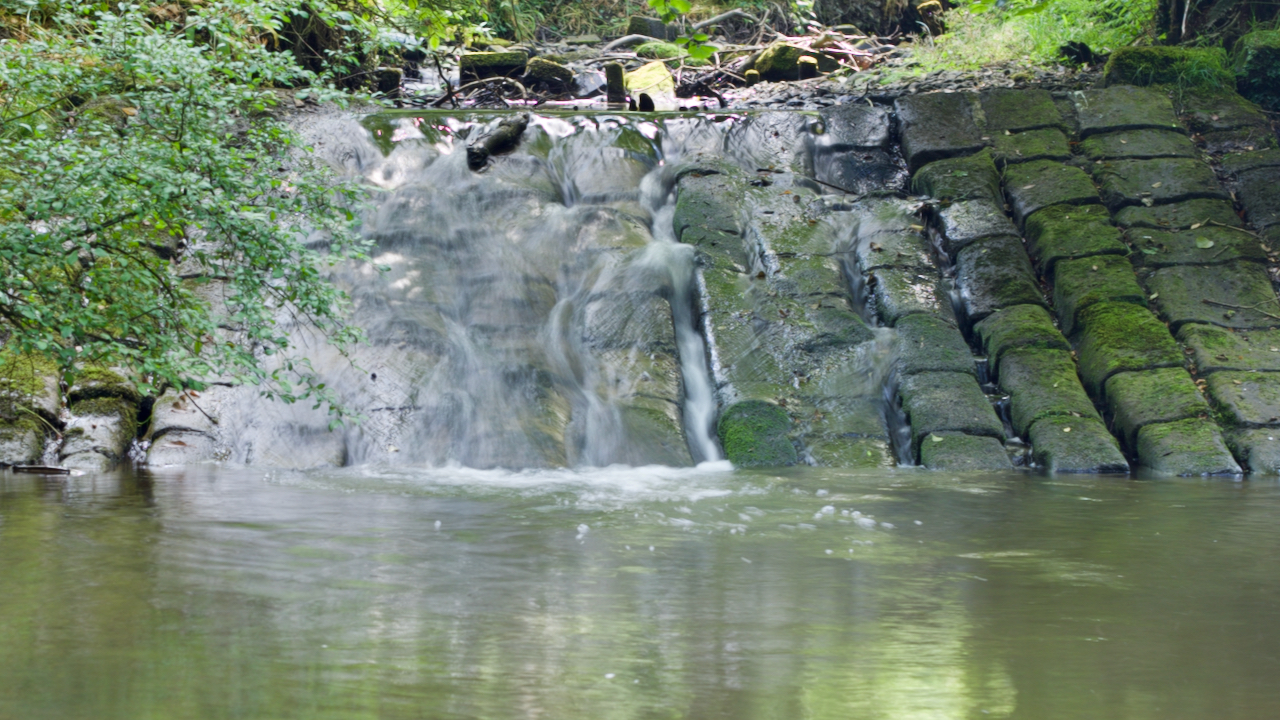Just below the familiar crossing of Scugdale Beck on the Cleveland Way are these remains of a weir.
The crossing is known as Bittling Mill Wath1“View Map: Yorkshire XLII.14 (Faceby; Whorlton) – Ordnance Survey 25 Inch England and Wales, 1841-1952.” Maps.nls.uk, 2022, maps.nls.uk/view/125625958.[Accessed 16 July 2022] — ‘wath’ meaning a ford — but the weir is more likely to be associated with a fulling mill that was sited about 200m downstream powered by a race which ran on the north side of the beck2“HER Map: North York Moors National Park.” HER Nos: 6570/1. North York Moors National Park, 2022, www.northyorkmoors.org.uk/discover/archaeology/her-map.[Accessed 16 July 2022].
The bittling mill was 80m or so upstream of the crossing, although the NYM HER records it as a flax mill3“HER Map: North York Moors National Park.” HER No: 6566. North York Moors National Park, 2022, www.northyorkmoors.org.uk/discover/archaeology/her-map.[Accessed 16 July 2022].
Bittling or beetling was a process whereby linen cloth was battered by repeated hammering to tighten the weave4Wikipedia Contributors. “Beetling.” Wikipedia, Wikimedia Foundation, 27 Nov. 2021, en.wikipedia.org/wiki/Beetling.[Accessed 16 July 2022].
Linen weaving from flax was a flourishing industry in lower Scugdale where “bleaching grounds of considerable extent” were recorded in 1808. 5“Parishes: Whorlton | British History Online.” British-History.ac.uk, 2022, www.british-history.ac.uk/vch/yorks/north/vol2/pp309-319#anchorn4. [Accessed 16 July 2022]. Here the cloth would have been laid on the ground to be whitened by the action of the sunlight6Wikipedia Contributors. “Bleachfield.” Wikipedia, Wikimedia Foundation, 27 July 2021, en.wikipedia.org/wiki/Bleachfield. [Accessed 16 July 2022].
- 1“View Map: Yorkshire XLII.14 (Faceby; Whorlton) – Ordnance Survey 25 Inch England and Wales, 1841-1952.” Maps.nls.uk, 2022, maps.nls.uk/view/125625958.[Accessed 16 July 2022]
- 2“HER Map: North York Moors National Park.” HER Nos: 6570/1. North York Moors National Park, 2022, www.northyorkmoors.org.uk/discover/archaeology/her-map.[Accessed 16 July 2022]
- 3“HER Map: North York Moors National Park.” HER No: 6566. North York Moors National Park, 2022, www.northyorkmoors.org.uk/discover/archaeology/her-map.[Accessed 16 July 2022]
- 4Wikipedia Contributors. “Beetling.” Wikipedia, Wikimedia Foundation, 27 Nov. 2021, en.wikipedia.org/wiki/Beetling.[Accessed 16 July 2022]
- 5“Parishes: Whorlton | British History Online.” British-History.ac.uk, 2022, www.british-history.ac.uk/vch/yorks/north/vol2/pp309-319#anchorn4. [Accessed 16 July 2022]
- 6Wikipedia Contributors. “Bleachfield.” Wikipedia, Wikimedia Foundation, 27 July 2021, en.wikipedia.org/wiki/Bleachfield. [Accessed 16 July 2022]

Leave a Reply